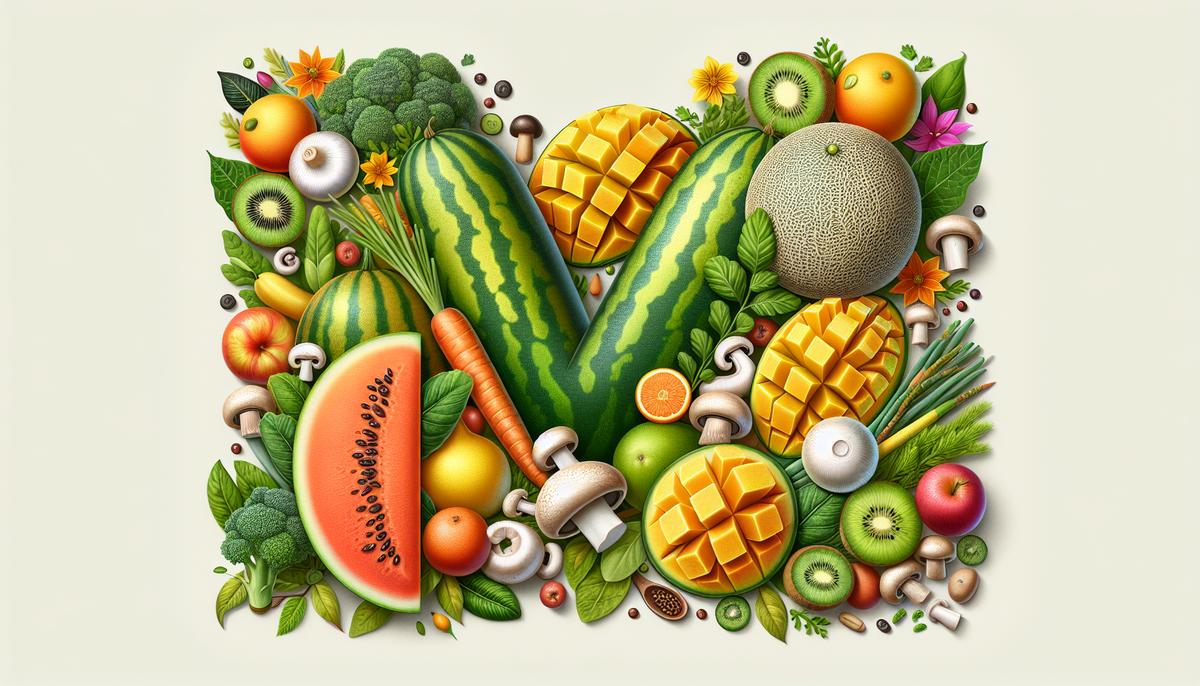Fruits and vegetables are nature’s treasure troves of flavor and nutrition. Among the vast variety available, those starting with the letter ‘M’ offer unique tastes and incredible health benefits. From the creamy richness of macadamias to the crisp freshness of manoa lettuce, each item brings its own set of culinary possibilities and nutritional perks. This article will take you on a journey through a list of fruits and vegetables that start with ‘M,’ exploring their distinct characteristics, health benefits, and delightful ways to include them in your meals. Whether you’re a seasoned cook or just starting to explore healthier eating habits, there’s something here to inspire everyone.
Fruits that start with M
Macadamia
Macadamia nuts, native to Australia, are known for their rich, buttery flavor and delightful crunch. These nuts are often enjoyed on their own as a snack or added to various dishes for an extra layer of texture and taste. Macadamias are particularly popular in baking, where they add a luxurious touch to cookies, cakes, and other desserts.
Nutritionally, macadamias are a powerhouse. They are high in healthy monounsaturated fats, which can help reduce bad cholesterol levels and support heart health. Additionally, they provide a good source of dietary fiber, essential vitamins like B1 and magnesium, and antioxidants, which help combat oxidative stress in the body.
In the kitchen, macadamias can be used in both sweet and savory dishes. Try adding chopped macadamias to your morning oatmeal for a delightful crunch, or use them as a crust for fish or chicken to create a gourmet meal at home. They also make a great addition to salads and can be transformed into a creamy, dairy-free nut butter.
Mamey Sapote
Mamey sapote is a tropical fruit native to Central America, easily recognized by its brown, rough skin and vibrant orange flesh. Its flavor is often described as a mix between sweet potato and pumpkin, with notes of almond and honey. The texture is smooth and creamy, making it a delightful addition to various dishes.
This fruit is not just delicious but also packed with nutritional benefits. Mamey sapote is rich in vitamins A and C, both of which are vital for maintaining healthy skin and boosting the immune system. Additionally, it contains significant amounts of potassium, which is essential for heart health and muscle function. The fruit is also a good source of dietary fiber, aiding in digestion and promoting a feeling of fullness.
Culinary uses for mamey sapote are diverse. It can be eaten fresh, added to smoothies for a tropical twist, or used in desserts like ice cream and pies. In some cultures, it’s also used to make beverages or added to savory dishes for a unique flavor profile. The seeds, when roasted, can be ground into a powder and used as a flavoring agent in various recipes.
Mandarins
Mandarins are small, easy-to-peel citrus fruits that are a favorite for their sweet and juicy segments. Originating from China, these fruits are now grown in many parts of the world and are a staple in many households. Their vibrant orange color and refreshing taste make them a popular choice for snacks, salads, and desserts.
Nutritionally, mandarins are a great source of vitamin C, which is essential for immune function, skin health, and collagen production. They also provide fiber, potassium, and several antioxidants, including flavonoids, which have anti-inflammatory properties and can help protect against chronic diseases.
In the culinary world, mandarins can be enjoyed in numerous ways. They can be eaten on their own, added to fruit salads, or used as a topping for yogurt and oatmeal. Mandarins also pair well with savory dishes, adding a burst of sweetness to salads, salsas, and even roasted meats. Their zest can be used to infuse a citrusy aroma into baked goods and marinades.
Mango
Mangoes are tropical fruits that are beloved worldwide for their juicy, sweet, and slightly tangy flavor. Originating from South Asia, mangoes come in various varieties, each with its own unique taste and texture. The bright orange flesh is not only delicious but also visually appealing, making mangoes a favorite in many dishes.
When it comes to nutrition, mangoes are a powerhouse of vitamins and minerals. They are rich in vitamin C, which supports immune health, and vitamin A, which is essential for vision and skin health. Mangoes also contain dietary fiber, which aids in digestion, and a variety of antioxidants that help protect the body from oxidative stress.
In the kitchen, mangoes are incredibly versatile. They can be eaten fresh, blended into smoothies, or added to salads for a tropical twist. Mangoes are also a popular ingredient in desserts like sorbets, cakes, and puddings. In savory dishes, they can be used to make chutneys, salsas, and marinades, adding a sweet and tangy flavor that complements a variety of meats and vegetables.
Mangosteen
Mangosteen, often referred to as the “queen of fruits,” is a tropical fruit known for its sweet and tangy flavor. The fruit has a thick, purple rind and juicy, white segments inside. Native to Southeast Asia, mangosteen is prized for its unique taste and numerous health benefits.
This exotic fruit is a nutritional gem. Mangosteen is rich in antioxidants, particularly xanthones, which have been shown to have anti-inflammatory and anti-cancer properties. It is also a good source of vitamin C, which supports the immune system and skin health. Additionally, mangosteen provides dietary fiber, which aids in digestion and promotes a healthy gut.
Mangosteen can be enjoyed in various ways. The fruit can be eaten fresh, with the segments easily separated from the rind. It can also be used in desserts, such as fruit salads, ice creams, and puddings. Mangosteen juice is a popular beverage in many tropical countries, and the fruit can also be used to make jams and preserves.
Maradol Papaya
Maradol papaya is a large variety of papaya that originates from Mexico and Central America. It is easily recognizable by its yellow-orange skin and sweet, orange flesh. This tropical fruit is known for its refreshing taste and numerous health benefits, making it a popular choice for a healthy diet.
Nutritionally, Maradol papaya is an excellent source of vitamins A and C, both of which are crucial for maintaining healthy skin and a strong immune system. The fruit also contains papain, an enzyme that aids in digestion and helps break down proteins. Additionally, Maradol papaya is rich in dietary fiber, which promotes healthy digestion and can help maintain a healthy weight.
In culinary terms, Maradol papaya is incredibly versatile. It can be eaten fresh, added to fruit salads, or blended into smoothies for a tropical twist. The fruit can also be used in savory dishes, such as salsas and salads, where its sweetness complements the other ingredients. Additionally, Maradol papaya can be used to make desserts like sorbets, puddings, and fruit tarts.
Mediterranean Medlar
The Mediterranean medlar, also known as loquat, is a small, pear-shaped fruit with a unique flavor that combines the sweetness of apple and the tartness of apricot. Native to the Mediterranean region, this fruit is enjoyed for its juicy flesh and delightful taste.
Mediterranean medlar is packed with nutritional benefits. It is an excellent source of vitamins A and C, both of which are essential for maintaining healthy skin and a strong immune system. The fruit also contains antioxidants, such as flavonoids and carotenoids, which help protect the body from oxidative stress. Additionally, medlar is a good source of dietary fiber, which supports healthy digestion and helps regulate blood sugar levels.
In the kitchen, Mediterranean medlar can be used in a variety of ways. It can be eaten fresh, added to fruit salads, or used to make jams and preserves. The fruit can also be cooked into sauces and compotes, which pair well with both sweet and savory dishes. Additionally, medlar can be used to make desserts like pies, tarts, and cakes, adding a unique flavor to your creations.
Medjool Dates
Medjool dates are a type of dried fruit that are known for their large size, soft texture, and rich, caramel-like flavor. Originating from the Middle East, these dates are often referred to as the “king of dates” due to their superior quality and taste. Medjool dates are a popular snack and ingredient in various dishes.
Nutritionally, Medjool dates are a powerhouse of energy. They are high in natural sugars, making them a great source of quick energy. They also provide dietary fiber, which aids in digestion and helps maintain healthy blood sugar levels. Additionally, Medjool dates are rich in essential minerals like potassium, magnesium, and copper, which support various bodily functions.
In the kitchen, Medjool dates can be used in a variety of ways. They can be eaten on their own as a sweet snack, stuffed with nuts or cheese for a gourmet appetizer, or chopped and added to salads and baked goods. Medjool dates can also be blended into smoothies or used to make natural sweeteners like date syrup and date paste, which can be used as healthier alternatives to refined sugar in various recipes.
Mulberries
Mulberries are small, sweet berries that come in various colors, including black, red, and white. These berries are native to Asia and have been enjoyed for their delicious taste and numerous health benefits for centuries. Mulberries have a unique flavor that is a mix of sweetness and tartness, making them a delightful addition to various dishes.
Nutritionally, mulberries are a rich source of vitamins and minerals. They are high in vitamin C, which supports the immune system, and vitamin K, which is essential for blood clotting and bone health. Mulberries also contain antioxidants like resveratrol, which has anti-inflammatory properties and can help protect against chronic diseases. Additionally, they provide dietary fiber, which aids in digestion and promotes a healthy gut.
In the culinary world, mulberries can be used in a variety of ways. They can be eaten fresh, added to fruit salads, or used to make jams and preserves. Mulberries also make a great addition to baked goods like muffins, pies, and cakes, adding a burst of flavor and color. Additionally, mulberries can be dried and used as a natural sweetener or added to trail mixes for a healthy snack.
Muscadine Grapes
Muscadine grapes are a type of grape native to the southeastern United States. These grapes are larger than typical table grapes and have a thick skin and a distinct, sweet flavor. Muscadine grapes come in various colors, including bronze, purple, and black, and are enjoyed for their unique taste and numerous health benefits.
Nutritionally, muscadine grapes are a powerhouse of antioxidants. They contain high levels of polyphenols, including resveratrol, which has been shown to have anti-inflammatory and anti-cancer properties. Muscadine grapes are also a good source of vitamins C and K, both of which are essential for maintaining healthy skin and supporting the immune system. Additionally, they provide dietary fiber, which aids in digestion and helps regulate blood sugar levels.
In the kitchen, muscadine grapes can be used in a variety of ways. They can be eaten fresh, added to fruit salads, or used to make jams and jellies. Muscadine grapes are also used to make wine and juice, which are enjoyed for their rich flavor and health benefits. Additionally, these grapes can be cooked into sauces and compotes, which pair well with both sweet and savory dishes.
Vegetables that start with M
Manoa Lettuce
Manoa lettuce, also known as butter lettuce, is a type of leafy green that is known for its tender leaves and mild, buttery flavor. Native to Hawaii, Manoa lettuce is a favorite for salads and wraps due to its delicate texture and pleasant taste.
Nutritionally, Manoa lettuce is a great source of vitamins and minerals. It is high in vitamin A, which is essential for maintaining healthy vision and skin. The lettuce also provides vitamin K, which supports bone health and blood clotting. Additionally, Manoa lettuce contains antioxidants like beta-carotene, which help protect the body from oxidative stress.
In the kitchen, Manoa lettuce can be used in a variety of ways. It is perfect for salads, where its tender leaves and mild flavor can shine. Manoa lettuce also makes a great base for wraps, providing a healthy and low-carb alternative to tortillas. Additionally, the lettuce can be used as a garnish or added to sandwiches for a fresh and crunchy texture.
Mo Qua
Mo Qua, also known as fuzzy melon or hairy gourd, is a type of vegetable that is popular in Asian cuisine. It has a mild flavor and a texture that is similar to zucchini, making it a versatile ingredient in various dishes. The vegetable is covered in tiny, hair-like structures, which give it a unique appearance.
Nutritionally, Mo Qua is a low-calorie vegetable that is rich in vitamins and minerals. It is a good source of vitamin C, which supports the immune system and skin health. The vegetable also contains dietary fiber, which aids in digestion and helps maintain a healthy weight. Additionally, Mo Qua provides essential minerals like potassium and magnesium, which support various bodily functions.
In the kitchen, Mo Qua can be used in a variety of ways. It can be stir-fried with other vegetables and proteins for a quick and healthy meal. The vegetable can also be added to soups and stews, where its mild flavor and tender texture complement the other ingredients. Additionally, Mo Qua can be stuffed with meat or seafood and baked for a delicious and nutritious dish.
Morel Mushrooms
Morel mushrooms are a type of wild mushroom that is highly prized for their unique flavor and texture. These mushrooms have a distinctive honeycomb-like appearance and a rich, earthy taste that makes them a favorite among chefs and food enthusiasts. Morel mushrooms are typically foraged in the wild, adding to their allure and exclusivity.
Nutritionally, morel mushrooms are a good source of vitamins and minerals. They are high in vitamin D, which is essential for bone health and immune function. The mushrooms also provide vitamin B6, which supports brain health and energy metabolism. Additionally, morel mushrooms contain antioxidants that help protect the body from oxidative stress and inflammation.
In the kitchen, morel mushrooms can be used in a variety of ways. They are often sautéed with butter and garlic to highlight their rich flavor. Morel mushrooms can also be added to pasta dishes, risottos, and omelets for a gourmet touch. Additionally, they can be stuffed with cheese or meat and baked for a delicious appetizer or side dish.
Mushrooms
Mushrooms are a type of fungi that come in various shapes, sizes, and flavors. Common varieties include button mushrooms, shiitake mushrooms, and portobello mushrooms. Mushrooms are known for their umami flavor, which adds depth and richness to various dishes. They are a staple in many cuisines around the world.
Nutritionally, mushrooms are a low-calorie food that is rich in essential nutrients. They are a good source of B vitamins, including riboflavin and niacin, which support energy metabolism and brain health. Mushrooms also contain antioxidants like selenium and ergothioneine, which help protect the body from oxidative stress. Additionally, mushrooms are one of the few plant-based sources of vitamin D, which is essential for bone health.
In the kitchen, mushrooms can be used in a variety of ways. They can be sautéed, grilled, or roasted as a side dish or added to soups, stews, and casseroles for extra flavor and texture. Mushrooms also make a great meat substitute in vegetarian dishes, such as mushroom burgers or stuffed mushrooms. Additionally, they can be used to make sauces, gravies, and broths, adding depth and richness to your recipes.
Mustard Greens
Mustard greens are a type of leafy green vegetable that is known for its peppery flavor and nutritional benefits. These greens are a staple in Southern cuisine and are often enjoyed cooked or raw in various dishes. Mustard greens have broad, dark green leaves and a slightly bitter taste that adds a unique flavor to salads, soups, and stir-fries.
Nutritionally, mustard greens are a powerhouse of vitamins and minerals. They are high in vitamins A, C, and K, all of which are essential for maintaining healthy skin, immune function, and bone health. The greens also provide dietary fiber, which aids in digestion and promotes a healthy gut. Additionally, mustard greens contain antioxidants like beta-carotene and flavonoids, which help protect the body from oxidative stress and inflammation.
In the kitchen, mustard greens can be used in a variety of ways. They can be sautéed with garlic and olive oil for a quick and healthy side dish. Mustard greens can also be added to soups and stews, where their peppery flavor complements the other ingredients. Additionally, the greens can be used raw in salads or blended into smoothies for a nutrient-packed meal.




